
When you think of Chinese restaurants in Venezuela, they remind you of all styles, from the big and luxurious ones, with their imposing fish tanks from the entrance, to the little places, where you would stop to eat something with your colleagues from work or college, while having a cold beer. That was the glory! Today, there are many reasons why we can't go to these restaurants, but that doesn't mean we can't enjoy this delicious food, which apart from having an incredible flavor, yields in quantities, and can be very diverse, and allows you to add the ingredients you prefer.

Ya solo nos queda empezar a trabajar, esta es una receta bastante rápida, lo primero que necesitaremos será hacer un arroz blanco sin sal, de preferencia desde el día anterior, pero si no tienes, puedes hacerlo como yo, que lo realice cuatro horas antes, espere que se enfriara y lo metí en la nevera. Es importante que quede un poco duro, porque el se terminara de cocer nuevamente durante la preparación. También es recomendable sellarlo, esto se hace colocando un poquito de aceite en la olla, y moviendo el arroz constantemente, hasta que el grano termine con un color blancuzco. Yo hice 3 tazas de arroz por 6 de agua, con lo que comimos el equivalente a 6 personas, (aunque éramos 3, pero comimos 2 veces jajajajaja).
Now we just have to start working, this is a pretty quick recipe, the first thing we will need is to make a white rice without salt, preferably from the day before, but if you don't have it, you can do it like I did, make it four hours before, wait for it to cool down and put it in the fridge. It is important that it is a little hard, because it will finish cooking again during the preparation. It is also advisable to seal it, this is done by placing a little oil in the pot, and moving the rice constantly, until the grain ends up with a whitish color. I made 3 cups of rice for 6 cups of water, with which we ate the equivalent of 6 people, (although we were 3, but we ate 2 times hahaha).
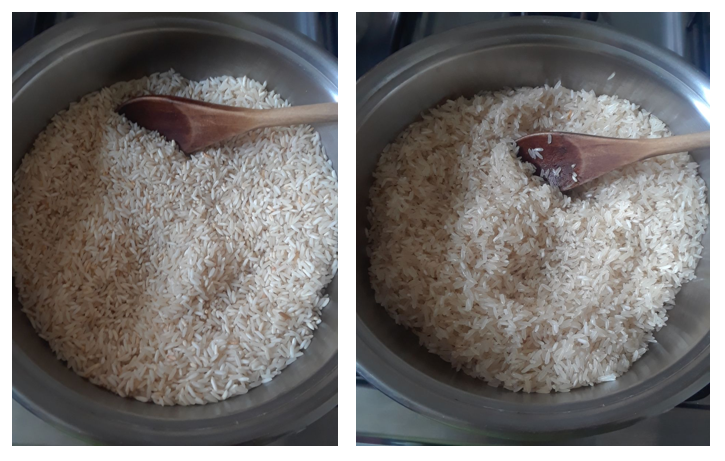
Los ingredientes clásicos son:
1 Zanahoria entre 80 y 100 ramos
Celery o Apio España 120 gramos
Cebollín o cebolletas 20 gramos
Salsa de soja
Brotes de soya (en mi caso no los pude conseguir).
4 dientes de ajo grandes
Aceite vegetal, o manteca de cerdo para freír
Entre los ingredientes opcionales están:
(Para esa cantidad de arroz yo use 500 gramos de pollo, pero puedes usar 100 a 150 gramos de proteínas variadas).
Pollo
Carne
jamón
Cerdo o chuleta ahumada
Camarón
Guisantes
Jengibre
2 huevos
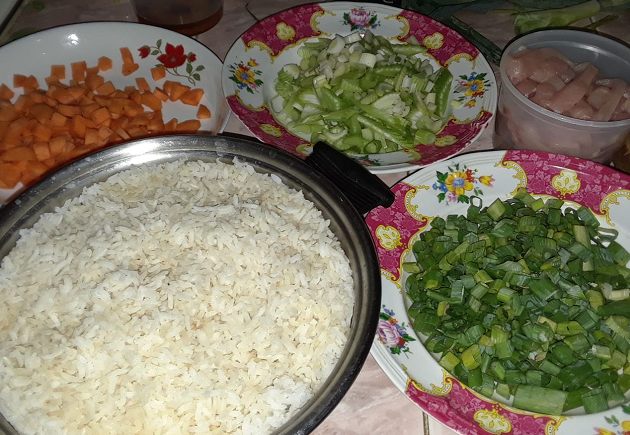
The classic ingredients are:
1 Carrot between 80 and 100 grams
Celery 120 grams
Chives 20 grams
Soy sauce
Soya sprouts (in my case I couldn't get them).
4 large garlic cloves
Vegetable oil, or pork lard for frying
Optional ingredients include:
(For that amount of rice I used 500 grams of chicken, but you can use 100 to 150 grams of various proteins)
Chicken
Meat
ham
Pork or smoked pork chop
Shrimp
Peas
Ginger
2 eggs
El primer paso es sacar el arroz de la nevera, y con las manos limpias me aseguró que este suelto, sin partes compactadas.
The first step is to take the rice out of the fridge, and with clean hands he assured me that it is loose, with no compacted parts.
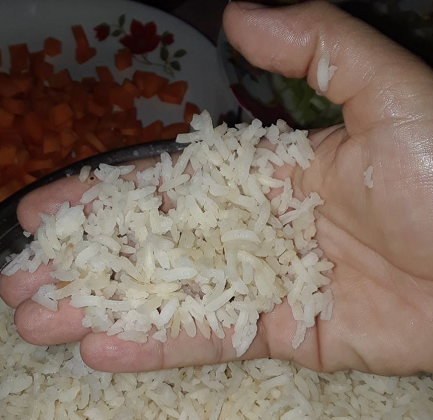
El segundo paso que debemos hacer es nuestro mise in place de vegetales, cortamos nuestro celery o apio España, necesitamos el tallo lo podemos cortar a nuestro gusto, yo lo corte al sesgo, en diagonal. También picamos la parte superior del cebollín, y lavamos la zanahoria la troceamos en cubos, finalmente cortamos finamente el ajo, y el jengibre si deseamos utilizarlo.
The second step we must do is our mise in place of vegetables, we cut our celery, we need the stem we can cut to our liking, I cut it to on siflet, diagonally. We also chop the top of the chives, and wash the carrot, cut it into cubes, finally we cut the garlic finely, and the ginger if we want to use it.
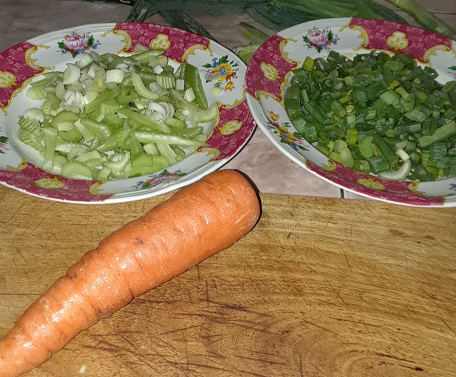
El tercer paso es limpiar nuestra proteína, en mi caso solo use pollo, pueden comprar pechuga ya que es más fácil de limpiar y cortar en cubos, yo use muslo y pechuga porque considero que el muslo tiene un poco más de sabor.
The third step is to clean our protein, in my case I only used chicken, you can buy breast because it is easier to clean and cut into cubes, I used thigh and breast because I think the thigh has a little more flavor.
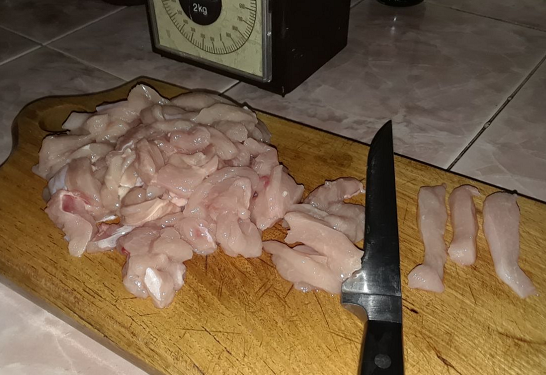

(Recommendation 1: It is very important that you take care not to generate cross contamination when preparing this dish. Although everything will end up together, when cutting we must keep them separate, wash the chopping board, as well as the knife between one and another protein).
El cuarto paso es poner a calentar nuestro wok, o un caldero alto, con la manteca de cerdo o el aceite vegetal, yo use aceite, y en lo que esté bien caliente, añadir el pollo. Una vez que está dorándose añadir el ajo y el jengibre, movemos constantemente para que no se queme.
The fourth step is to heat our wok, or a tall pot, with the lard or vegetable oil, I used oil, and in what is very hot, add the chicken. Once it is browning add the garlic and ginger, we move constantly so that it does not burn.
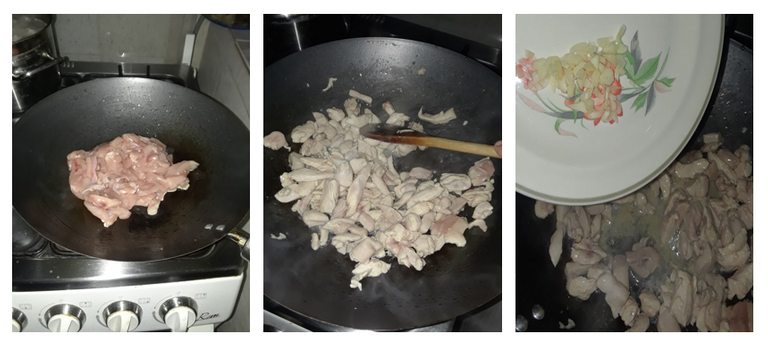

(Recommendation 2: If you make several meats, you should sauté them individually, about 5 minutes, and remove them from the heat, and then sauté the vegetables in that fat).
El quinto paso es saltear la zanahoria, de todos nuestros vegetales es el más duro, por ello es el primero que coloco junto al pollo, aparte agrego un poquito de sal.
The fifth step is to sauté the carrot, of all our vegetables it is the hardest, that is why it is the first one I place next to the chicken, apart from that I add a little bit of salt.
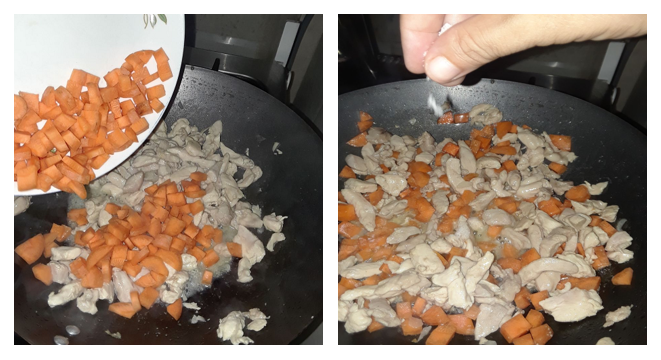

(Recommendation 3: The amounts of salt at this point, are not to give flavor to the dish, but for the food to dehydrate, ie release some of its juices, and be mixed with all ingredients in the wok or the pot).
El sexto paso es agregar el resto de los vegetales, exceptuando el cebollín o cebolleta, y seguir revolviendo constantemente, en este punto yo agrego otra pizca de sal.
The sixth step is to add the rest of the vegetables, except the chives, and keep stirring constantly, at this point I add another pinch of salt.
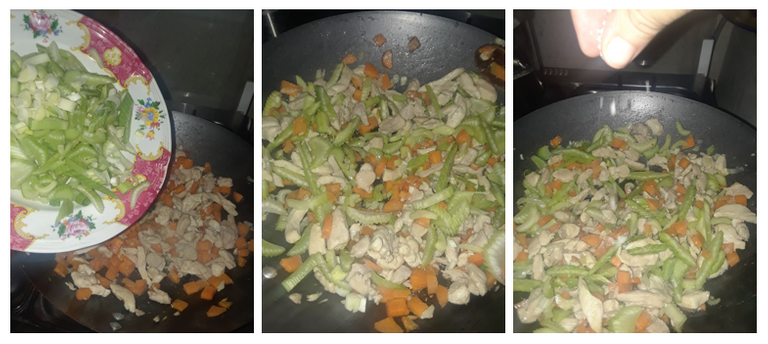
El séptimo paso es incorporar el arroz poco a poco, y junto al arroz viene la salsa de soja, que es el corazón de este plato. Y nos mantenemos revolviendo.
The seventh step is to incorporate the rice little by little, and next to the rice comes the soy sauce, which is the heart of this dish. And we keep stirring.


(Recommendation 4: There are many brands of soy sauce, if you want the original flavor the ideal is that you go to a Chinese market, and buy a Chinese soy sauce since its quality is another level, of this sauce with 4 or 5 dahs or touches is enough, to color all the rice and give it that flavor that we look for, if you don't get it, try with any brand of your preference, in this case if you must go adding and trying, I used almost half a bottle, but it is for the quality).
El octavo paso es rectificar de sal, en este punto si queremos salar el alimento, aquí es donde radica la importancia de que el arroz no tenga sal en un principio, ya que la salsa de soja es salada, y hemos agregado pocos de sal durante la preparación.
The eighth step is to rectify the salt, at this point if we want to salt the food, this is where the importance lies that the rice has no salt at first, since the soy sauce is salty, and we have added little salt during preparation.
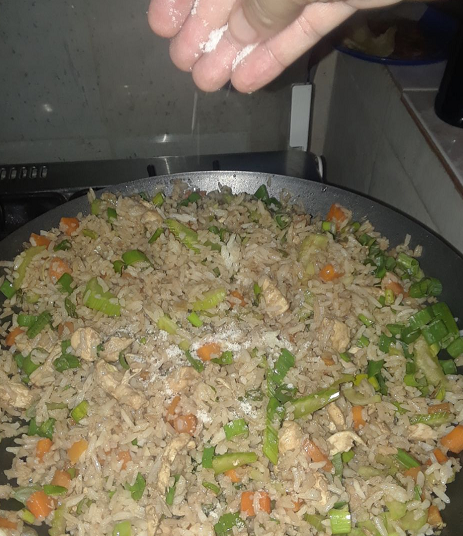
El noveno paso, es agregar el cebollín o cebolleta, revolver y apagar, el se terminará de cocinar con el calor del arroz, y así no corre riesgo de quemarse.
The ninth step is to add the chives, stir and turn off, the cooking will be finished with the heat of the rice, and so it does not run the risk of burning.
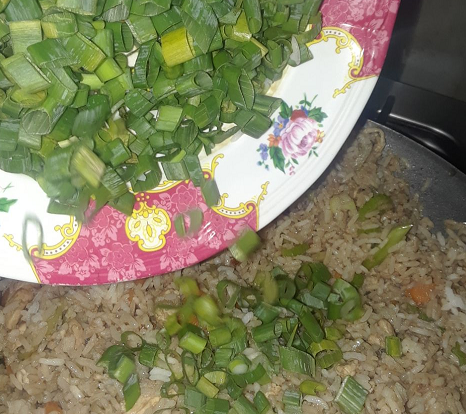
El décimo paso es revolver el huevo, salpimentar, y hacer una tortilla rápida, yo use dos huevos en esta ocasión, esto es opcional, sirve como decoración. Una vez estén listas tus tortillas, se enrollan y se cortan, las puedes dejar en esas finas tiras largas, o cortar esa serpentina a la mitad, es una cuestión de gustos.
The tenth step is to scramble the egg, season it, and make a quick omelet, I used two eggs on this occasion, this is optional, it serves as decoration. Once your tortillas are ready, roll them up and cut them, you can leave them in those long thin strips, or cut that serpentine in half, it's a matter of taste.
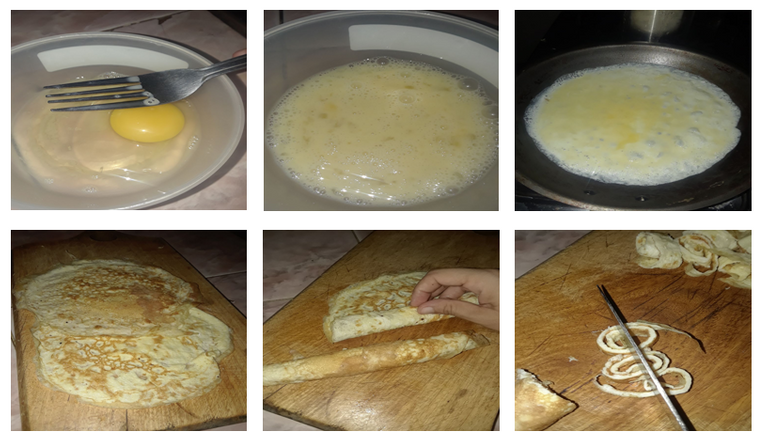
El paso que queda es disfrutar, hacer este tipo de arroz es muy fácil, además que ayuda a rescatar alimentos, que se nos han quedado varados en la nevera, los pasos son muy simple recuerda.
Cortar todo
Cocinar las carnes
Cocinar los vegetales
Integrar el arroz y la soja
Agregar el cebollín, y la tortilla si deseas.
The step that remains is to enjoy, making this type of rice is very easy, in addition to helping rescue food, we have been stranded in the refrigerator, the steps are very simple remember.
Cut everything
Cooking meats
Cooking the vegetables
Integrate rice and soy
Add the chives, and the tortilla if you wish.
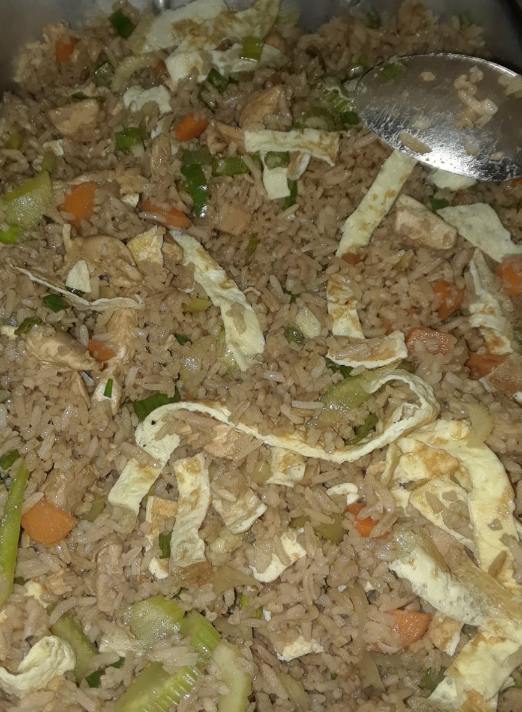
Si aparte de esto deseas complementarlo con un exquisito Shop Suey, que además es saludable no lleva nada de grasa para equilibrar la balanza, puedes encontrar la receta aquí.
If you want to complement it with an exquisite Shop Suey, which is also healthy and has no fat to balance the scale, you can find the recipe here.
Esto es todo por hoy espero que les haya gustado y me dejen sus comentarios, les mando un abrazo, y les deseo ¡buen provecho!
This is all for today, I hope you liked it and leave me your comments, I send you a hug, and I hope enjoy your food!
Images chef propierty of Imagen de OpenClipart-Vectors en Pixabay
Todas las fotos son de mi propiedad / All photos are my property

Mi comida preferida! Gracias por compartir con nosotros tu receta, tiene una pinta increíble!
Gracias, estaba divino. Espero que puedas hacerla en casa, los resultados son increíbles. 😃🥘
excelente ese arroz, me provocó
Muchas Gracias, esa es la idea que te dejes seducir por el arroz. 🤣 Espero puedas prepararlo, una vez que esta todo picado es super rápido.
Tu arroz luce espectacular. Quería preguntarte cuál es el rendimiento de una taza de arroz una vez le agregas todo lo demás? En raciones normales...;)
Saludos, gracias por tomarte el tiempo de leer y comentar, una taza de arroz crudo al cocinarse se triplica, con esto en mente yo considero que lo ideal por porción serian dos tazas de arroz cocido por persona, eso siguiendo la linea de los platos abundantes que te sirven en los restaurantes, sabes que quedas como una boa, y debes descansar para poder moverte jajaja 😂.
Si lo vas a complementar con Shop Suey, Lumpias y/o pan, puede ser una taza y media de arroz cocido por porción, pero esto siempre variara según tu apetito, o dieta. Espero te haya ayudado a resolver tu duda. 😃
Tu arroz se ve espectacular ya me dio hambre. saludos
¡Hola! Muchas gracias, me alegra que te haya gustado, espero tengas la oportunidad de prepararlo. 😀
Se ve delicioso!!!
¡Saludos! Gracias por tomarte el tiempo de leer y comentar, si estaba muy bueno. 🤤
Congratulations @mixbar.show! You have completed the following achievement on the Hive blockchain and have been rewarded with new badge(s) :
You can view your badges on your board and compare yourself to others in the Ranking
If you no longer want to receive notifications, reply to this comment with the word
STOPThat fried rise look super tasty 😋
Greetings! I'm glad you liked it 😃, it was very tasty, and also very easy to prepare, I hope you dare to do it at home, the result is divine. 😍